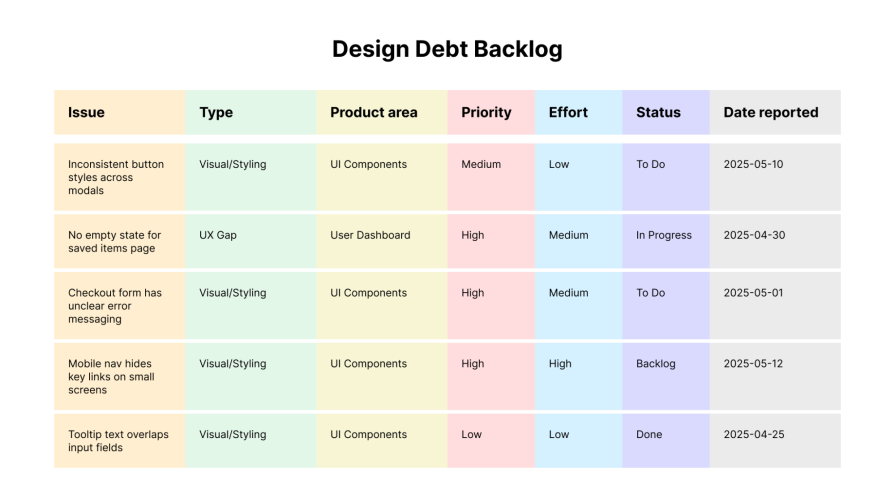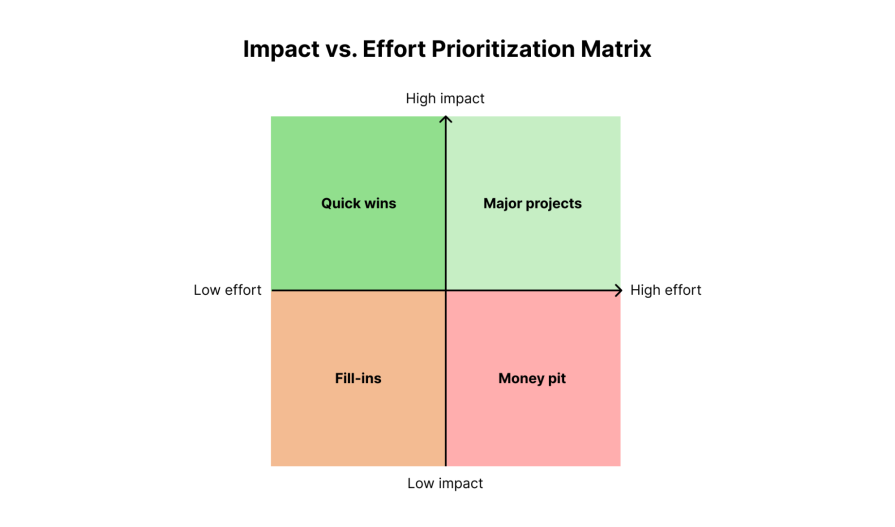When innovation meets opportunity, speed to market becomes everything. You’ve identified a unique solution to a real problem, uncovered a gap in the market, or tapped into an emerging user need. Whether you’re an early-stage startup building something new or a growth team riding a trend or platform shift, launching fast often wins over waiting for perfection.

Even if your product’s user experience isn’t perfect or fully built out, the cost of waiting is often greater than the cost of shipping early with imperfections. But that tradeoff only works if you have a plan to clean it up later on.
In a high-speed environment, teams typically launch products quickly and iterate based on user feedback. Design decisions are often made under pressure, with speed and limited resources top of mind, which frequently leads to compromises. Design system guidelines are often ignored, components are hastily assembled, and accessibility is temporarily set aside.
These shortcuts and workarounds accumulate into the form of design debt.
Like financial debt, you’re making a tradeoff, except instead of money, you’re borrowing time by skipping the consistency and usability in your designs. Debt comes with interest, which you’ll have to pay back later in the form of usability issues, inconsistent UI, and developer rework. The longer that it’s ignored, the more expensive it becomes to fix.
Eventually, design debt slows down your team. What began as a tradeoff for speed ultimately damages your product’s user experience. Support teams are burdened with user complaints. Developers face a mountain of bugs and inconsistencies. And your team’s velocity begins to stall.
In this post, we’ll unpack how design debt builds up, its hidden costs, and how to manage it — so you can move fast and build things that last.
Design debt often starts with seemingly small choices. In my first year as a UX designer, I realized that design teams rarely follow the neat, linear design process taught in school. Sometimes we skipped research entirely, relying on assumptions to move quickly. Developers implemented flows based on undocumented design decisions, which got copied or repurposed in later features. This led to confusion and inconsistencies in the UX.
Sometimes developers would custom-code a component instead of using the existing design system library because it would take less time. But when the design system was later updated, the hard-coded elements didn’t use the tokens to match the colors, typography, or spacing, leading to inconsistent UI that had to be cleaned up later.
Some companies were conscious. When designs couldn’t be implemented exactly as intended — due to tech limitations or time constraints — I negotiated a quick workaround that compromised the user experience. I wasn’t always happy about it, but when there are a hundred different priorities, you have to pick your design battles. To top it all off, sometimes development would merge code into production without a proper design desk check or QA, which would lead to more inconsistencies slipping through unnoticed until it was too late.
One project I worked on was a rushed MVP feature that we had to deliver quickly to help retain a major client. We prioritized speed to market over conducting thorough research and understanding user expectations. Some key decisions were based on leadership’s assumptions about what the feature should be, rather than validated insights.
The final result had confusing flows and unclear labels. We never revisited it — just moved on. Those design issues are still live today.
All cross-functional stakeholders, including product, development, and design, contributed to our design debt piling up. It wasn’t just one decision or team that created all the debt. User research was skipped. Designs weren’t properly documented. Decisions were made in silos without cross-functional alignment or quality control.
Over time, these trade-offs and shortcuts led to increasing inconsistencies in UX and UI.
What felt harmless in the moment slowly became a source of design debt, making the product harder to maintain, more difficult to scale, and ultimately more confusing for users.
From the user’s perspective, you might notice inconsistencies in the way actions are performed, such as two different ways to upload a file. This could be due to new patterns being implemented while old ones remain outdated and untouched. Ultimately, users are left to deal with the frustration. This can leave them with a bad impression of your product and your brand, as small difficulties start to impact their experience, and for B2B products, their workflow and efficiency.
If design debt is left unaddressed, a redesign becomes inevitable. Customers could churn and choose a competitor that offers them a more pleasant and professional user experience. This diagram explains this well:

Like credit card debt, design debt can sneak up on you. A few small “convenient” decisions snowball until you’re buried under inconsistencies and legacy patterns. Fixing one broken component now means touching dozens of screens.
This debt doesn’t just affect users — it strains internal relationships. Stakeholders argue about priorities. Teams disagree on what’s broken or who’s responsible for fixing it. Eventually, it becomes the elephant in the room. No one owns it, and everyone avoids it.
It also kills morale. Designers feel their work doesn’t matter when MVPs and band-aid fixes become the norm. Without time to improve or test, good design becomes an afterthought. Burnout sets in. People leave.
Meanwhile, it gets harder for sales to demo the product. Customer success fields more complaints. Engineering starts to doubt the value of design. And the cycle continues.
Design debt issues may get prioritized here and there when time and resources permit, or when a bug becomes too blatant to ignore. But over the long term, your team needs a proper strategy to manage and address design debt. Otherwise, its downstream effects will start to show up in the product experience and across the organization.
Here are some strategies to help your team manage and eliminate design debt over the long term:
Design debt may be top of mind for designers, but not for the rest of your team. First, ensure everyone is on the same page by educating your PM partners and engineering counterparts on what design debt is and why it matters.
Once everyone has an understanding of what design debt is and how it’s created, you can then discuss its impact and how to tackle it moving forward.
Next, identify a few major examples of how design debt is impacting the user experience. These may include visual inconsistencies that seem jarring to the user, confusing product flows, or incorrect implementations of designs.
Communicate any customer feedback or observations around these issues, and highlight the frustrations and workarounds that users currently have to employ in order to achieve their goals.
Getting your counterparts on board can be a challenging task, as they may not view design debt as a pressing issue and may have other priorities to manage. But, no matter how long it takes, collaborate with product managers and engineers to align on why addressing design debt is a strategic priority and not just a “nice to have”. It helps to have an advocate from each party to support your cause and convince the rest of their team that addressing design debt is worthwhile. This removes the need to justify the time and effort allocated towards design debt every time.
Once your team is aligned and agrees that tackling design debt is a priority, it doesn’t always mean they’ll treat it like one. Developers may still see it as low-value work compared to building new features, and it can easily fall to the bottom of the to-do list. That’s where having a structured process can help shift the team’s perspective on design debt and ensure it’s treated as a shared, ongoing responsibility rather than an annoyance.
Start by creating a centralized design debt backlog, where you log each instance of design debt. Every ticket should clearly outline the problem, user expectations, and proposed solution. Some items may require updated designs, references to design system components, or input from content designers.
You can categorize the issues by area of the product or type of fix needed to make it easier to filter and prioritize:

During planning, whether for the upcoming sprint or milestone, work with your PM and engineering leads to review and prioritize the backlog. Use a framework, such as an impact vs. effort matrix, to identify high-impact, low-effort tasks. These are your quick wins, which can be completed with minimal resources.
Encourage teams to work on them early in the cycle rather than pushing them to the end. Otherwise, unexpected requests may arise mid-cycle that divert attention from design debt tasks:

For larger initiatives that will take more effort, like redesigning a page or flow, pitch these ideas to your PMs to see if they can become a candidate under your company’s goals. This way, your engineering teams can allocate more resources towards them as they become strategic projects rather than just design debt.
Now that you have a system in place to tackle design debt, don’t forget about improving existing processes to ensure that fewer design debt issues slip through into production.
Collaborate with your fellow designers to emphasize the importance of thorough design documentation. This means including information about user interactions, edge cases, component states, and details such as color, typography, and spacing specifications.
It’s also helpful to take note of any decisions made that impact the designs or feedback received so that anyone who views your design file will have the updated context around the latest designs:

After your designs are handed off, your job doesn’t end there. Establish routine desk checks with development and QA to ensure that the designs are implemented to spec. Oftentimes, design debt slips through unnoticed due to poor quality assurance. Any changes or deviations from the design should be documented to minimize the risk of unintended inconsistencies entering production.
Design debt is easy to accumulate, but it can be uncomfortable to pay off. It can remain somewhat unnoticeable until it’s not, and by then, it’s often spread across multiple areas of your product. Users are accustomed to workarounds and confusing UI, and fixing it requires significant resources, alignment, and commitment.
Design debt can begin as small tradeoffs, poor documentation, or rushed decisions that ultimately lead to poor user experiences, inconsistent interfaces, and an accumulation of support tickets. Without deliberately addressing it, design debt can quietly undermine the user experience of your product and negatively impact team morale, slowing progress when you want to move quickly.
Tackling design debt isn’t just a design team’s responsibility. It’s a product-wide commitment to quality and maintainability. By establishing a structured approach, gaining buy-in from your project manager and engineering counterparts, and refining team processes, you can alleviate the burden of past debt and move forward toward a more consistent, scalable, and user-friendly product. Sometimes, moving fast can get you where you’re going, but slowing down helps you move forward for longer, without needing to backtrack.
Addressing design debt may feel like a pause, but it’s actually a step toward building sustainable practices and delivering intentional user experiences.
LogRocket's Galileo AI watches sessions and understands user feedback for you, automating the most time-intensive parts of your job and giving you more time to focus on great design.
See how design choices, interactions, and issues affect your users — get a demo of LogRocket today.

Small actions can have large consequences in complex systems. Here’s how UX designers can manage dependencies so users feel informed and in control rather than blocked or blindsided.

This article examines when hero sections are necessary in digital products, when they create friction, and how to evaluate them using UX goals, primary actions, user flow impact, and real-world alternatives.

AI speeds up tasks like research synthesis, ideation, and first-draft wireframes, but it can’t replace clarity, taste, or decision-making. Here’s a grounded look at what AI actually does well in UX right now.

Discover how to craft UX-friendly hero sections with examples, design tips, and strategies that drive engagement and conversion.